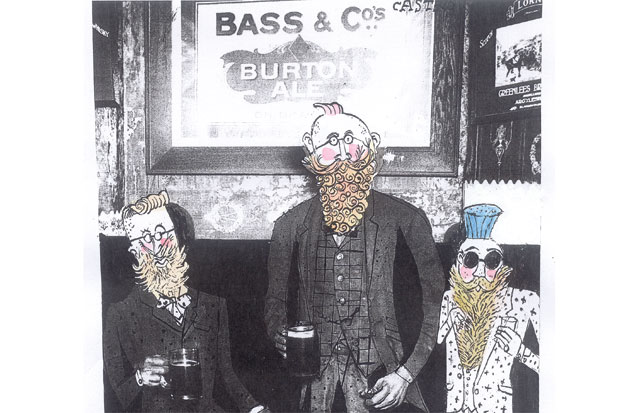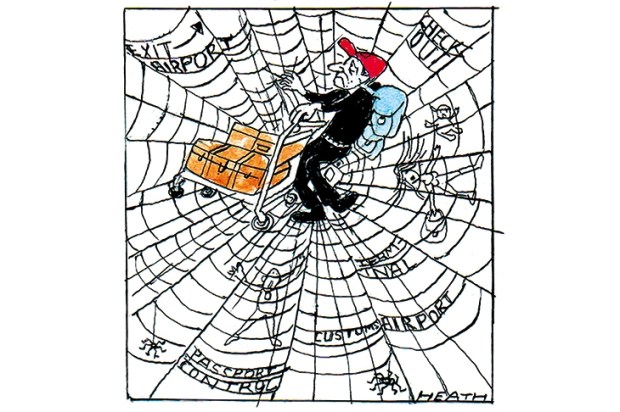Listen
Calling all hipsters, it’s time to get the razor out! You have hit peak beard. You’ve had a decade of getting away with those narrow, short trousers and the studiously thought-out socks; with the Victorian archdeacon beards and the shaven sides to your heads.
It wasn’t even that good while it lasted. Like gay fashionistas — but without any humour or bite — the hipsters stood in front of the wardrobe for an age every morning. And then proceeded to pick out random combinations of clothes straight from the £1 reject basket in a rural Norfolk branch of Help the Aged: Barbours, cable-knit cardies and jumpers from Ferris Bueller’s Day Off, twinned with Clark Kent specs. As Reuben Dangoor put it in his inspired YouTube attack, ‘Being a Dickhead’s Cool’, hipsters dress like nerds without getting the grades.
All fashion depends for its survival on a group of misguided lemmings who live for conformity dressed up as anti-conformity. And the fashion lemmings have always been with us: from the Earl of Essex’s moody fan club in the 1590s in their studious, melancholy black outfits to Beau Brummell’s regency cult — all dark coats, full-length trousers, crisp shirts and cravats that took an hour to tie in the morning. The difference is that Essex and Beau Brummell not only looked good; they were also original.
When hipsters grow a twirly-whirly moustache or sport a farmhand’s collarless shirt, last worn by John Clare in Cambridgeshire in 1832, they think they look good, clever and amusing. They end up being completely derivative, plundering a ragbag of tired and worn influences: fin de siècle facial hair lifted from Aubrey Beardsley’s Yellow Book; waistcoats that channel the Young Fogeys and the retro-gent magazine The Chap; and those silly short trousers, courtesy of the American fashion designer Thom Browne, who’s been flogging them for nearly a decade alongside carefully cropped jackets.
It’s the knowing irony that’s so trying. There’s nothing wrong with beards per se. It’s fine when scary Roy Keane — assistant-manager of Ireland and Aston Villa — grows a thumping great black-and-white badger of a beard (which he shaved off last week). His was an unironic beard, grown on a unilateral whim, not at the behest of a fashion movement to go with a series of ludicrous, widely-copied accessories.
The first hipsters were a highly original bunch. ‘Hip’ is an early-20th-century term of confused origin: perhaps related to ‘hop’, slang for opium; or to being so relaxed that you spend plenty of time lying on your hip, while smoking your opium. As for ‘hipster’, it’s thought to have been invented by Harry ‘The Hipster’ Gibson, a boogie-woogie and stride pianist in wartime Harlem. His 1944 album Boogie Woogie in Blue included the song ‘Handsome Harry the Hipster’. The album came with a glossary, ‘For Characters who Don’t Dig Jive Talk’, which described hipsters as ‘characters who like hot jazz’.
There’s a world of difference between pianists working out a dazzling new school of jazz in Harlem in the 1940s and graduates with novelty beards in Hoxton in 2014. And the difference is talent. Today’s hipsters may largely work in the creative industries — but how can anyone be creative whose whole persona is so imitative?
To be fair to the movement, new hipsterism did have some interesting sociological birth pangs. ‘Hipsterism was a reaction to the David Beckham metrosexual male, not least the obsession with removing every speck of body hair,’ says Robert O’Byrne, author of The Perfectly Dressed Gentleman and Style City: How London became a Fashion Capital. ‘Hipsters grew out of the need for the fashion-conscious to have an alternative to a trend, once it became too mainstream. Look at The Only Way Is Essex, where tanned hairlessness is now the suburban norm.
‘One thing that remains unchanged is attention to cleanliness and detail. Hipsters are very groomed, their beards and moustaches are meticulously maintained and just look at how neat their hair always is.
‘As ever, the gay influence is important. Urban gays became very keen on hairlessness as a means of emphasising body development, but once that became heterosexually acceptable, an alternative needed to be found: now being hirsute is the gay norm. And hipsterism is essentially an urban thing, heavily reliant on coffee-drinking, shopping and consumer life. It’s bohemianism without the dirt.’
Hipsterism is also getting pretty long in the tooth. As early as 1999, the magazine Shoreditch Twat was lampooning the haircuts and clothes of young men in east London. In 2005, the Channel 4 series Nathan Barley, written by Charlie Brooker and Chris Morris, had a lead character who called himself a ‘self-facilitating media node’, as well as a DJ, webmaster and guerrilla film-maker. Already the programme was nailing the hipster’s liking for silly, impractical bicycles and tiresome names — like Jonatton Yeah?, chief editor of fashion bible Sugar Ape. More recently, a needlessly cruel edge to hipster criticism has emerged: including a video game, Hipster Hunter 2014, where you track down and assassinate the poor lambs. There’s even a Keep Calm and Kill All Hipsters poster.
To give them their due, the hipsters have shown great stamina in the face of sustained ridicule. When Will Self attacked the phenomenon recently, hipster-defenders compared him to the snobbish brigade who demonised the poor as chavs. As some hipsters themselves pointed out, there is a difference. The chav-haters were picking on the poor. Hipsters are a largely middle-class phenomenon.
As a fellow member of the middle classes, I don’t take against hipsters on class grounds, but for style reasons. Irony doesn’t work when it’s mainstream; original clothes just can’t be so derivative; and it’s never truly hip to look silly.
‘They’re selling hippie wigs in Woolworths, man,’ says Danny, the drug-dealer in Withnail and I, as he recognises the death throes of the 1960s. The hipster’s long decade has now run its course, too. Reach for the razor.
Got something to add? Join the discussion and comment below.
Get 10 issues for just $10
Subscribe to The Spectator Australia today for the next 10 magazine issues, plus full online access, for just $10.
Harry Mount is the author of How England Made the English.
You might disagree with half of it, but you’ll enjoy reading all of it. Try your first month for free, then just $2 a week for the remainder of your first year.














Comments
Don't miss out
Join the conversation with other Spectator Australia readers. Subscribe to leave a comment.
SUBSCRIBEAlready a subscriber? Log in